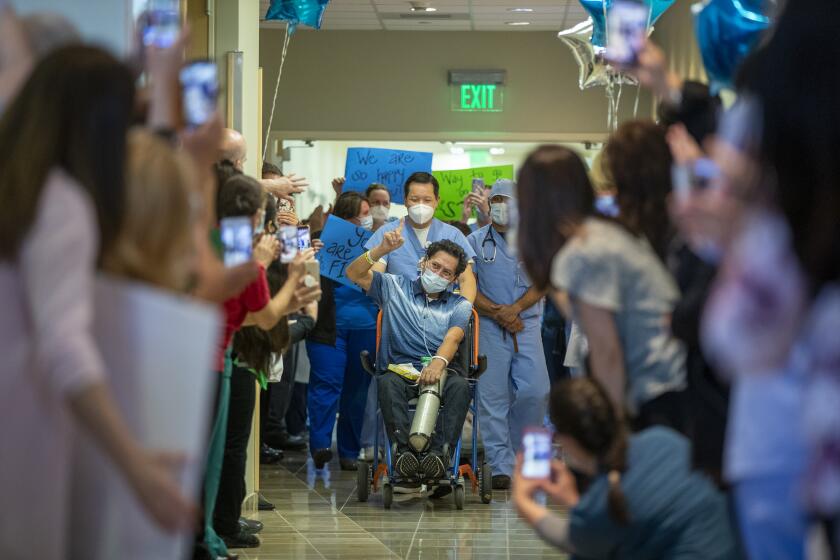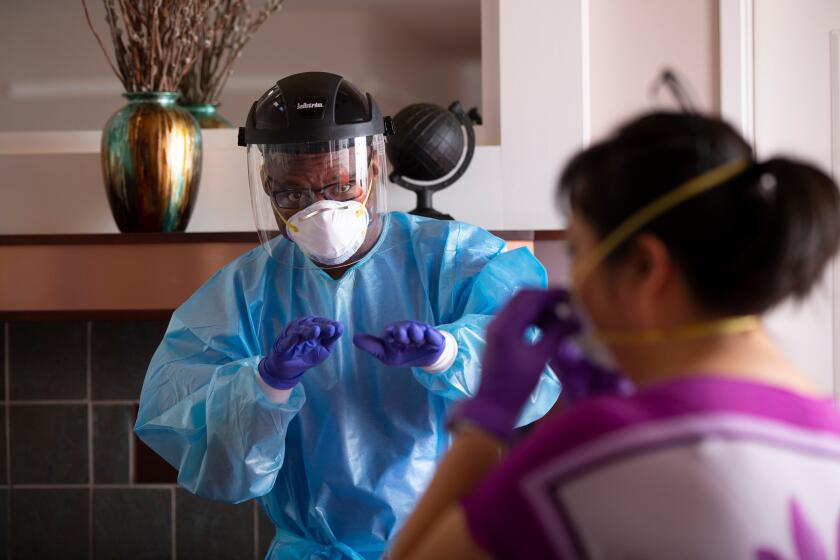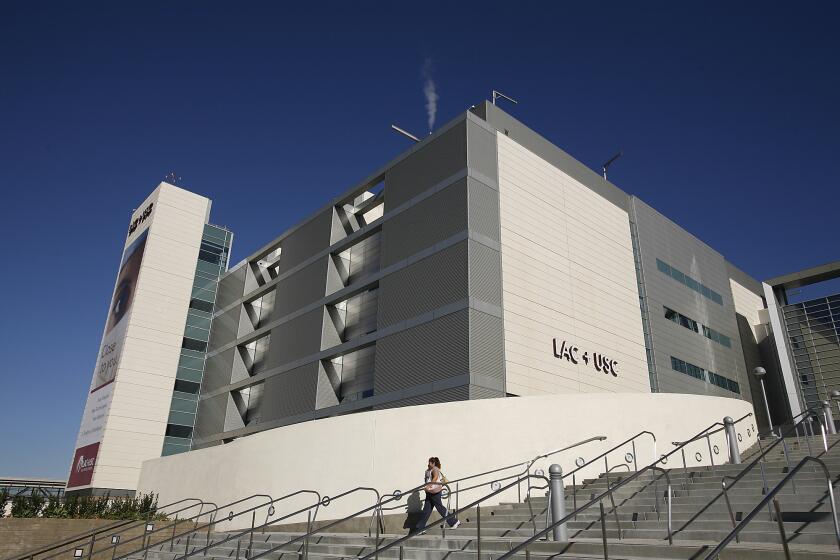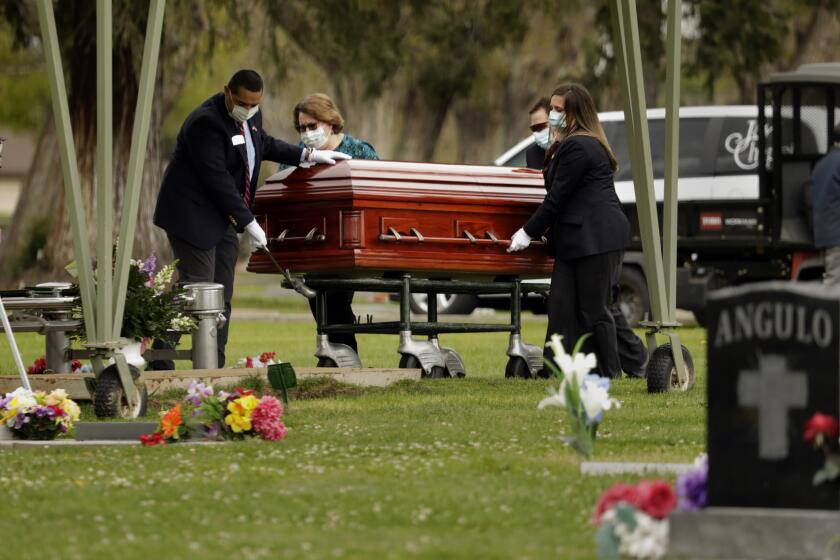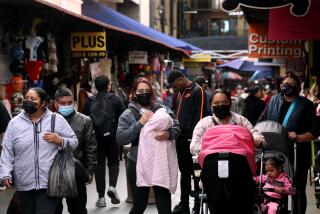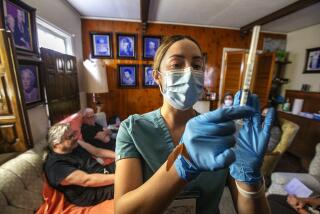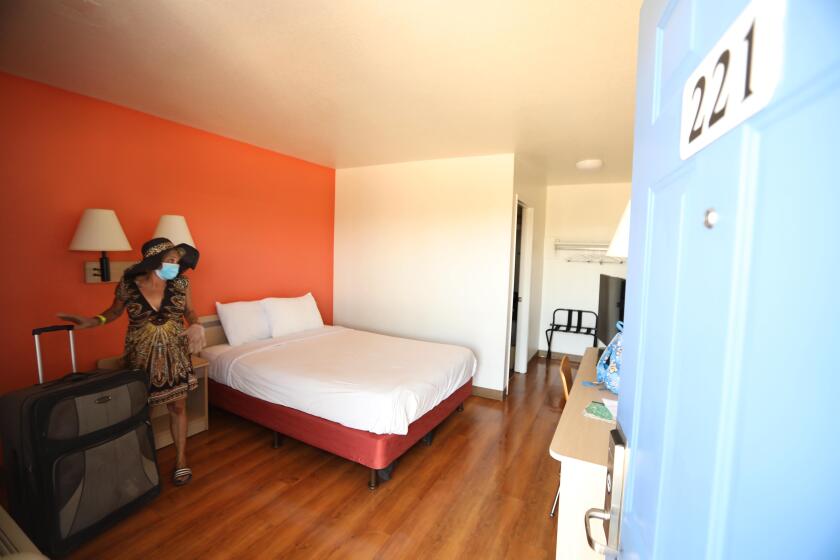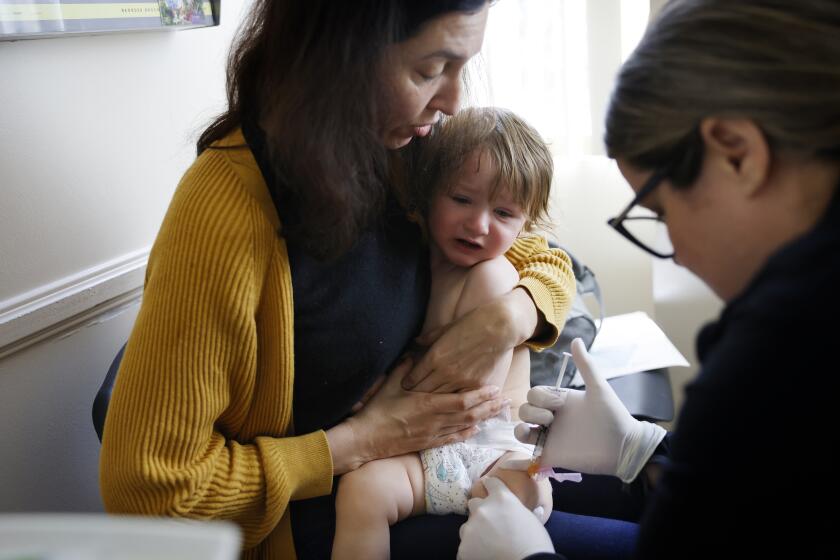New signs suggest coronavirus was in California far earlier than anyone knew
A man found dead in his house in early March. A woman who fell sick in mid-February and later died.
These early COVID-19 deaths in the San Francisco Bay Area suggest that the novel coronavirus had established itself in the community long before health officials started looking for it. The lag time has had dire consequences, allowing the virus to spread unchecked before social distancing rules went into effect.
“The virus was freewheeling in our community and probably has been here for quite some time,” Dr. Jeff Smith, a physician who is the chief executive of Santa Clara County government, told county leaders in a recent briefing.
How long? A study out of Stanford suggests a dramatic viral surge in February.
But Smith on Friday said data collected by the federal Centers for Disease Control and Prevention, local health departments and others suggest it was “a lot longer than we first believed” — most likely since “back in December.”
“This wasn’t recognized because we were having a severe flu season,” Smith said in an interview. “Symptoms are very much like the flu. If you got a mild case of COVID, you didn’t really notice. You didn’t even go to the doctor. The doctor maybe didn’t even do it because they presumed it was the flu.”
Just as New York has strong ties to travelers from Europe, who are believed to have brought the coronavirus there from Italy, the Bay Area is a natural hub for those traveling to and from China. Santa Clara County had its first two cases of COVID-19 almost a week before federal approval of emergency testing for the disease Feb. 4. Both were in travelers returning from Wuhan, China, where the virus was rampant.
These are some of the unusual new scenes across the Southland during the coronavirus outbreak.
In January and most of February, there was little, if any, community testing in California.
The CDC provided testing materials to only some health departments, with restrictions that confined testing and thus the tracking of the novel coronavirus to those who were sick or exposed to someone already known to have COVID-19. The federal agency’s focus was on cruise ships, with Princess Cruises’ Diamond Princess carrying the largest known cluster of COVID-19 cases outside of China. The first passenger tested positive for COVID-19 five days after the ship’s Jan. 20 departure from Japan. Eventually, 712 passengers and crew tested positive, and nine of them died.
COVID-19 did not reappear in the Bay Area until Feb. 27, when doctors finally decided to test a hospitalized woman who had been ill for weeks. She became the region’s first case of community-spread coronavirus.
But from there, almost every positive test pointed toward local spread. “When public health [officials] tried to track down the start of the disease … we weren’t able to find, specifically, a contact,” Smith told county supervisors. “That means the virus is in the community already — not, as was suspected by the CDC, as only in China and being spread from contact with China.”
Researchers still unsure how long the virus lurked are now turning to blood banks and other repositories to see if lingering antibodies can show them what was missed. A study funded by the National Institutes of Health is looking for virus antibodies in samples from blood banks in Los Angeles, San Francisco and four other cities across the country.
This week was one of the deadliest the nation has ever seen. These are the stories of front-line workers and victims across America.
Santa Clara County’s first community-spread case also became its first announced COVID-19 death.
Azar Ahrabi, 68, died March 9, the second COVID-19 fatality in California, five days after the first. For the first few weeks, the urban county that sits at the heart of Silicon Valley, home to Stanford University and tech giants Apple and Google, led California in coronavirus deaths.
Health investigators said they could find no source of Ahrabi’s infection. Her family members said she stayed mostly at home, taking care of her mother. She seldom drove, and she walked to a local grocery store to shop. But she and her mother lived in a Santa Clara apartment complex in a neighborhood with a high density of international residents.
Relatives said she showed signs of illness in mid-February. For more than a week, they gave only a passing thought that her fever and sudden fatigue might be tied to the horrifying news out of China.
Ahrabi’s son, Amir, said that when his mother checked into a medical clinic Feb. 20 and was diagnosed with a nonspecific pneumonia, she was prescribed antibiotics and sent home. The next day, her doctor admitted her to the intensive care unit.
Amir said he asked that she be tested for COVID-19, and doctors told him the county health department would not approve the test. She met none of the qualifying criteria.
New studies out of Stanford University and the CDC, taken together, suggest that the novel coronavirus spread quickly through the Bay Area.
Stanford’s virology lab, looking retroactively at some 2,800 patient samples collected since January, did not find the first COVID-19 cases until late February — from two patients who were tested Feb. 21 and Feb. 23. Neither of those patients, the researchers note in a letter published by the Journal of the American Medical Assn., would have met existing criteria for COVID-19 testing.
The California Department of Public Health and the CDC did not begin community surveillance for COVID-19 in Santa Clara County until March 5. Samples were collected from 226 coughing, feverish patients who visited four urgent care centers; 1 in 4 turned out to have the flu. The state tested samples from a subset of 79 non-flu patients. Nine of them had COVID-19.
The result suggested that 8% of people walking into the urgent care centers carried the novel coronavirus, an infection rate that mirrored the 5% infection rate at a Los Angeles medical center, the CDC said in a report published Friday.
Health workers tested 131 patients who came to LAC-USC Medical Center in mid-March with mild flu symptoms. Seven were infected with the novel coronavirus.
It is possible the coronavirus spread widely through the Bay Area in just two weeks, said Dr. Benjamin Pinsky, the pathologist who led the Stanford study. He said Stanford’s virology clinic saw a similar increase in cases once it was cleared by the federal government to begin running its own COVID-19 tests.
Pinsky said the virtual invisibility of COVID-19 in February followed by an 8% infection rate two weeks later is not “incompatible.... I think that all kind of fits together.”
Santa Clara County acted on the CDC’s local sampling immediately. Two days after the project ended, it and five other Bay Area counties ordered residents to stay home and schools and nonessential businesses to close. Azar Ahrabi by then was dead.
Amir said he sees his mother as on the cruel side of history, falling ill before Californians were ready to look for the virus already in their presence. For his mother, that realization came too late.
The first confirmed COVID-19 death in California was March 4 in Placer County, claiming the life of a 71-year-old man who had recently taken a Mexican cruise. A ship medical officer told The Times the man had developed symptoms during the Feb. 11-21 voyage, suggesting he brought the virus on board from California.
Two days later, March 6, San Jose authorities found a 70-year-old man dead in his home. The Santa Clara County medical examiner determined the man tested positive for COVID-19, according to records provided to The Times. The discovery of this second death was never publicly announced, and county health officials did not answer questions about the case.
Research by The Times showed he lived less than four miles from Azar Ahrabi, essentially off the same main road with an interstate between them.
The diagnosis of Ahrabi appeared to the family to make little difference in her steady decline. She was put into an induced coma and intubated with a ventilator. Family members were not allowed to see her. The county put them in quarantine and served a legal order to back that up.
In Madera, friends and family paid their respects by car to a woman who died from coronavirus. She was apparently infected after attending a March 10 funeral.
Physicians threw a slew of treatments at Ahrabi — including offering a controversial synthetic quinine used to treat malaria but using another experimental treatment, Remdesivir. But her liver failed, and her body rejected dialysis treatment. The ventilator could not deliver enough oxygen through her occluded lungs, and the hospital did not have a machine to infuse oxygen directly into her blood.
“She was essentially tested a week and a half after her first symptoms, and some of the treatments that were proposed and [that] we went with could have been way more effective if we — they — put them in place days ago,” Amir said.
Amir was ordered by Santa Clara County to go into quarantine the day his mother’s test result came back, and he never saw her alive again.
As she died, he stayed in his apartment with his grandmother, caring for the elderly woman without telling her the fate of her daughter. Only after the quarantine order was lifted, when the whole family could again gather, did they tell her Azar Ahrabi had died.
Iranian tradition dictated that the family wash her body and prepare it to eventually return to the earth, Amir said. Instead, the county health department required that she be sealed into a plastic bag for interment.
Times staff writer Melody Petersen contributed to this report.
More to Read
Start your day right
Sign up for Essential California for news, features and recommendations from the L.A. Times and beyond in your inbox six days a week.
You may occasionally receive promotional content from the Los Angeles Times.
